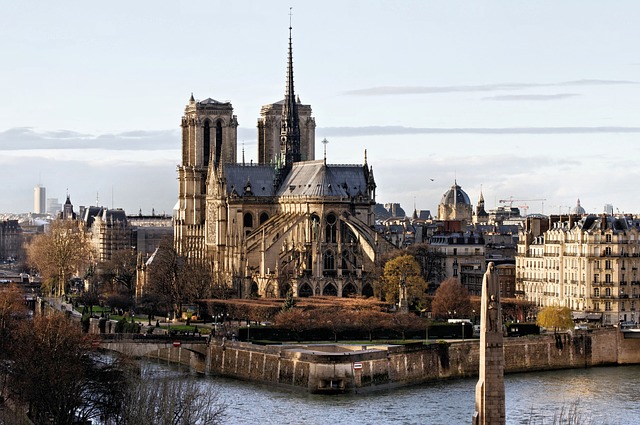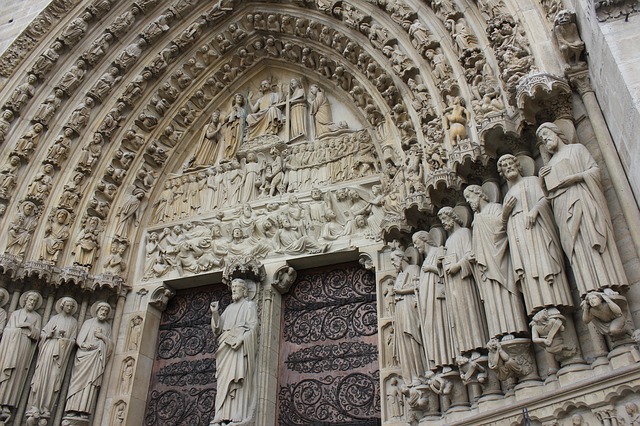Notre-Dame de Paris
Contents |
[edit] Introduction
Notre-Dame de Paris is a medieval Catholic cathedral on the Île de la Cité in Paris, France. It is one of the finest examples of French Gothic architecture, and one of the most famous churches in the world.
The cathedral was constructed on the ruins of two earlier churches, which were themselves on the site of a Gallo-Roman temple. Around 1160, Maurice de Sully, the bishop of Paris, conceived the idea of converting the ruins of the two basilicas into a single, larger religious building.
Notre-Dame is still used as an active Catholic church, as the cathedral of the Archdiocese of Paris; and is one of the most popular tourist attractions in France, with around 13 million visitors a year.
In popular culture, the cathedral is most famous as the setting for Victor Hugo’s classic historical novel ‘The Hunchback of Notre-Dame’, published in 1831.
[edit] Design and construction
Construction began on the cathedral in 1163, during the reign of Louis VII. Bishop de Sully, having conceived the project, devoted the rest of his life and wealth to its construction.
The cathedral is notable as one of the first buildings in the world to incorporate flying buttresses, which were required as the walls around the choir and nave began to develop stress fractures during construction. The architects designed single-arch buttresses to prevent the walls being pushed outwards under load.
The construction of the choir was completed in 1177, and the new High Altar was consecrated in 1182. Bishop de Sully died in 1196, and his successor, Eudes de Sully, pressed on with the construction of the transepts and the nave. The western façade was built between around 1208 and the mid-1240s.
The two early-Gothic towers crowning the western façade were constructed between 1210 and 1250, reaching 68 m (223 ft) in height.
The different styles seen at various heights on the west front and towers are an indication of the numerous architects who worked on the project over the decades. The most significant change came in the mid-13th century when the transepts were remodelled in the latest Rayonnant style, characterised by the radiating style of the spectacular rose window.
From the mid-13th century, the remaining elements – such as the elaborate statues, tympanum and gargoyles - were completed and the project was finally finished in 1345.
[edit] Post-completion
Notre-Dame has undergone significant alterations since it was completed. During the reigns of Louis XIV and Louis XV, major works were undertaken to modernise cathedrals throughout Europe. A large statue near the western entrance was destroyed in 1786, along with crypt tombs and stained glass windows.
During the French Revolution, as part of a ‘reasoned’ backlash against religious idolatry, the cathedral suffered desecration, and much of its imagery was damaged or destroyed. Most significantly, the 13th century spire was torn down, and the cathedral was re-purposed as a warehouse for storing food.
In 1845, an extensive restoration project was started, which lasted 25 years. It included the construction of a taller and more ornate spire, as well as the addition of chimeras.
The cathedral sustained further damage during the Second World War, and was rumoured to have been ear-marked for demolition by Hitler.
Another major maintenance and restoration programme began in 1991, and lasted until 2010. In 2014, most of the lighting was upgraded to LED lighting.
On Monday 15 April 2019, at around 7pm, fire ripped through the iconic cathedral. By 9am the following day, the centuries-old masterpiece of French Gothic architecture had suffered catastrophic damage to its roof and some of its contents, while the 90m-high oak and lead spire over the crossing had collapsed completely. For more information see: Notre Dame fire.
[edit] Related articles on Designing Buildings Wiki
- Cathedral of Brasilia.
- Cathedral.
- Centre Pompidou.
- Cologne Cathedral.
- Dwarf gallery.
- Eiffel Tower.
- Florence Cathedral.
- Flying buttress.
- Gargoyle.
- Lotus temple.
- Notre Dame fire.
- Notre Dame, a conservation perspective.
- Rose window.
- Sagrada Familia.
- St. Basil’s Cathedral.
- St. Paul’s Cathedral.
- St. Peter’s Basilica.
- The Louvre.
Featured articles and news
Infrastructure that connect the physical and digital domains.
Harnessing robotics and AI in challenging environments
The key to nuclear decommissioning and fusion engineering.
BSRIA announces Lisa Ashworth as new CEO
Tasked with furthering BSRIA’s impressive growth ambitions.
Public buildings get half a million energy efficiency boost
£557 million to switch to cleaner heating and save on energy.
CIOB launches pre-election manifesto
Outlining potential future policies for the next government.
Grenfell Tower Inquiry announcement
Phase 2 hearings come to a close and the final report due in September.
Progress from Parts L, F and O: A whitepaper, one year on.
A replicated study to understand the opinion of practitioners.
ECA announces new president 2024
Electrical engineer and business leader Stuart Smith.
A distinct type of countryside that should be celebrated.
Should Part O be extended to existing buildings?
EAC brands heatwave adaptation a missed opportunity.
Definition of Statutory in workplace and facilities management
Established by IWFM, BESA, CIBSE and BSRIA.
Tackling the transition from traditional heating systems
59% lack the necessary information and confidence to switch.
The general election and the construction industry
As PM, Rishi Sunak announces July 4 date for an election.
Eco apprenticeships continue help grow green workforce
A year after being recognised at the King's coronation.
Permitted development rights for agricultural buildings
The changes coming into effect as of May 21, 2024.

























